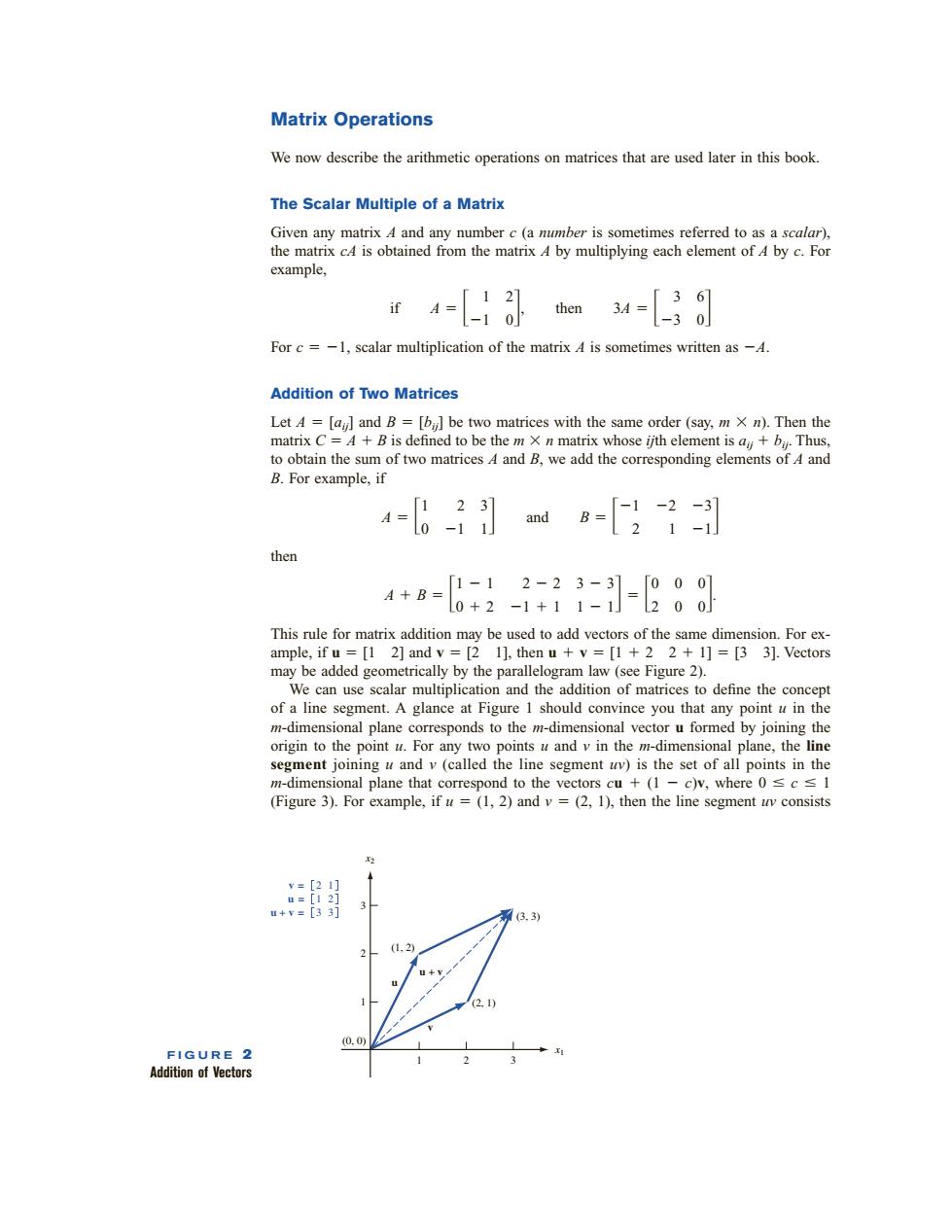正在加载图片...

Matrix Operations We now describe the arithmetic operations on matrices that are used later in this book. The Scalar Multiple of a Matrix Given any matrix A and any number c(a number is sometimes referred to as a scalar), the matrix cA is obtained from the matrix A by multiplying each element of A by c.For example, 4=[ 3A1 36 then -30 For c =-1,scalar multiplication of the matrix A is sometimes written as -A. Addition of Two Matrices Let 4 [ay]and B =[b]be two matrices with the same order (say,m x n).Then the matrix C=4 B is defined to be the m x n matrix whose ijth element is ay+by.Thus, to obtain the sum of two matrices A and B,we add the corresponding elements of A and B.For example,if 4=[07 -11 and then A+B=-1 [02-988 This rule for matrix addition may be used to add vectors of the same dimension.For ex- ample,if u [1 2]and v=[2 1],then u v=[1 +22+1]=[3 3].Vectors may be added geometrically by the parallelogram law(see Figure 2). We can use scalar multiplication and the addition of matrices to define the concept of a line segment.A glance at Figure 1 should convince you that any point u in the m-dimensional plane corresponds to the m-dimensional vector u formed by joining the origin to the point u.For any two points u and v in the m-dimensional plane,the line segment joining u and v(called the line segment uv)is the set of all points in the m-dimensional plane that correspond to the vectors cu +(1-c)v,where 0 scs1 (Figure 3).For example,if u =(1,2)and v=(2,1),then the line segment uv consists =[21] u=[12] u+y=[33] (3.3) (1,2 u+¥ (21) (00) FIGURE 2 Addition of VectorsMatrix Operations We now describe the arithmetic operations on matrices that are used later in this book. The Scalar Multiple of a Matrix Given any matrix A and any number c (a number is sometimes referred to as a scalar), the matrix cA is obtained from the matrix A by multiplying each element of A by c. For example, if A , then 3A For c 1, scalar multiplication of the matrix A is sometimes written as A. Addition of Two Matrices Let A [aij] and B [bij] be two matrices with the same order (say, m n). Then the matrix C A B is defined to be the m n matrix whose ijth element is aij bij. Thus, to obtain the sum of two matrices A and B, we add the corresponding elements of A and B. For example, if A and B then A B . This rule for matrix addition may be used to add vectors of the same dimension. For example, if u [1 2] and v [2 1], then u v [1 2 2 1] [3 3]. Vectors may be added geometrically by the parallelogram law (see Figure 2). We can use scalar multiplication and the addition of matrices to define the concept of a line segment. A glance at Figure 1 should convince you that any point u in the m-dimensional plane corresponds to the m-dimensional vector u formed by joining the origin to the point u. For any two points u and v in the m-dimensional plane, the line segment joining u and v (called the line segment uv) is the set of all points in the m-dimensional plane that correspond to the vectors cu (1 c)v, where 0 c 1 (Figure 3). For example, if u (1, 2) and v (2, 1), then the line segment uv consists 0 0 0 0 0 2 3 3 1 1 2 2 1 1 1 1 0 2 3 1 2 1 1 2 3 1 2 1 1 0 6 0 3 3 2 0 1 1 14 CHAPTER 2 Basic Linear Algebra 3 2 x2 x1 1 u u + v v (1, 2) (2, 1) (3, 3) (0, 0) v = 2 1 123 u = 1 2 u + v = 3 3 FIGURE 2 Addition of Vectors������������������������������